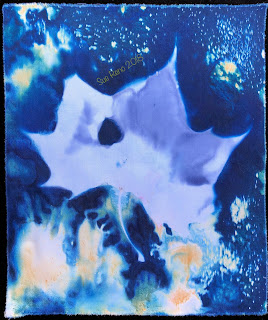I wanted to make one big print, as opposed to a set of smaller ones, so I did a mockup to figure out how much cotton sateen cloth to treat. The dark room I dry my treated fabric in is only partially heated, so the panel dried unevenly. This didn't trouble me, I regarded it as one more variable in a process that is rife with them. So here is the panel, with the glycerine leaves arranged, just before exposure.
There's not much sunshine to be had in December, so I left the panel out overnight to catch the next day's rays. The temperature dipped below freezing overnight, and I found the most wonderful frosty display the next morning.
To be clear, these designs are on top of the plastic that is covering the panel.
The frost formed along the lines of the leaves underneath. I knew from past experience that I was unlikely to see much distinct evidence of the frost patterns on the finished print, so I seized the brief moment when the morning sun hit and took these pictures.
There was some very nice leaf veining; again, I knew it would not all survive the rinse, so I took photos.
I love the fleeting, ephemeral imagery.
The golden bits are from soda ash added before exposure.
Here's the finished panel after rinsing and drying. I think it's just marvelous.
You can see a bit of patterning where the cyanotype chemicals aligned themselves with the threads in the cotton sateen.
Some of the unevenness of the initial treatment of the fabric also shows up.
Most of all I love the beautiful turquoise and lavender shades I got along with the Prussian blues.
I've got big plans for this one.
If you are new here, welcome! For the past year and a half I've been documenting my experiments with the wet cyanotype process. You can access all the information by clicking on the Wet Cyan tab in the top header, or click here.
And a reminder that you can also follow along on your social media of choice:
Facebook page:http://www.facebook.com/suerenostudio
Twitter feed: http://twitter.com/suereno
Tumblr: http://suerenostudio.tumblr.com
Instagram: https://www.instagram.com/sue_reno_studio/
Facebook page:http://www.facebook.com/suerenostudio
Twitter feed: http://twitter.com/suereno
Tumblr: http://suerenostudio.tumblr.com
Instagram: https://www.instagram.com/sue_reno_studio/

























































